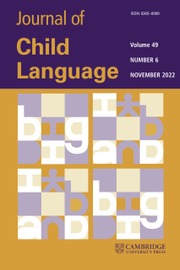Article contents
Children's comprehension of the distinction between want and need*
Published online by Cambridge University Press: 26 September 2008
Abstract
Two experiments examined the development of children's understanding of the difference between want and need. In experiment 1, children were tested on their knowledge that want represents an intrinsic desire whereas need represents an instrumental desire. Forty-five children between three and five years of age heard four stories in which one character encountered a problem, while another did not. A desirable object which could alleviate the problem was then introduced, and after both characters requested the object, the children were asked whether each character wants the object or needs it. Three-year-olds were unable to differentiate the two terms in such contexts, whereas four- and five-year-olds were significantly more likely to say that the character experiencing the problem needed the object, while the other wanted it. In experiment 2, 45 subjects between three and five years of age were tested on their understanding that a request employing need expresses a stronger desire than one employing want. Subjects were required to give an object to one of two characters, one of whom asked for it using need and the other using want. In this experiment, three-year-olds were equally likely to give the object to the character using want as to the one using need. Both four- and five–year–olds were significantly more likely to give the object to the character who used need. The results from these two experiments show that the understanding of the semantic and pragmatic difference between want and need develops at about four years of age.
Information
- Type
- Articles
- Information
- Copyright
- Copyright © Cambridge University Press 1995
Footnotes
Our thanks go to the staff and children of the following preschools which participated in this study — Alexandra, Chestnut, Dalhousie University children's centre, Happy Hollow, Lyceum, New Horizons, Purdy's Wharf children's centre, Tot 'n Tykes, World of the Little People. Thanks also to Sara Shepherd for her assistance in data collection and to the anonymous reviewers of an earlier version of this manuscript.
References
REFERENCES
- 6
- Cited by

